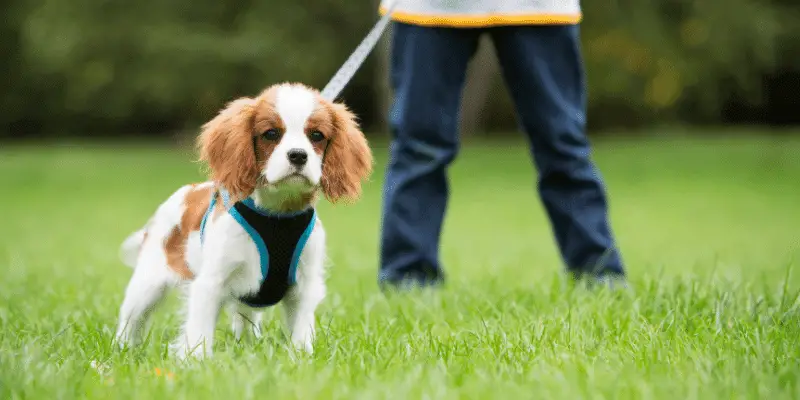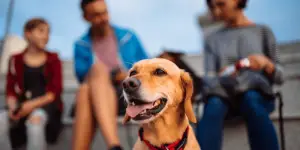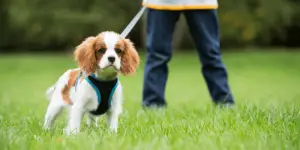
How to Walk a Puppy for the First Time
Although most dogs love nothing more than their daily walks, the experience can be unsettling and scary for puppies, at least initially. There will be a lot of new smells, sights, and sounds, which can overwhelm your puppy, so it’s important to take the right steps to prepare your young dog for the outdoors.
If your pooch is ready to venture outside and go on walks, our handy guide will help you learn exactly how to walk a puppy for the first time to make the task go as smoothly as possible. Don’t worry, your puppy will be walking like a pro in no time!
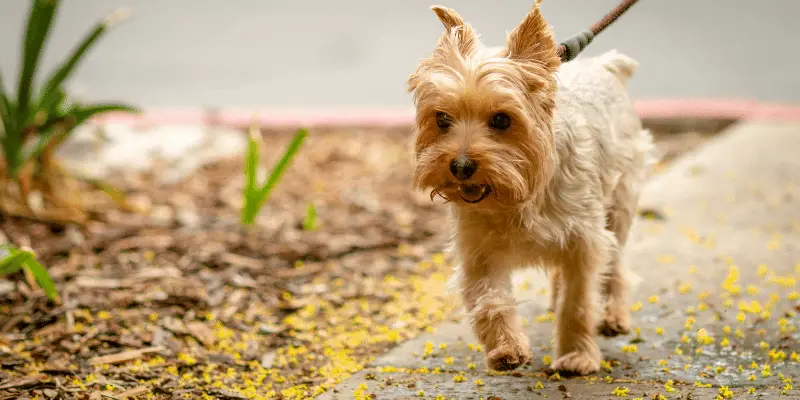
Taking Your Puppy for Its First Walk
Walking your puppy for the first time is exciting, but there are a few things you need to do to prepare your pooch for the great outdoors. The first (and most important!) step is to make sure your pup is up to date with their vaccinations as this will protect them from infectious diseases like canine parvovirus, canine distemper, kennel cough, parainfluenza, and leptospirosis.
Your puppy should have their first vaccination at around 8 to 10 weeks old, but this can be done as young as 4 to 6 weeks old. The second vaccination should be given a few weeks after your puppy’s first dose. You’ll need to wait one week after your pup’s second vaccination before you let them out in public areas.
At around 6 months to 12 months of age, your puppy will need a booster vaccination to keep the aforementioned diseases at bay. Once they are an adult, they’ll only need an annual booster vaccination.
After your puppy has had both of their vaccinations, you can start getting them used to wearing a harness and lead, ideally inside your home. Whenever you put your puppy’s harness and lead on, offer praise and a tasty treat. At first, leave the harness on for a few seconds, then gradually increase the duration.
If your puppy becomes agitated or stressed, remove the harness and lead immediately. You want your dog to view the equipment as a positive, not a negative!
When your puppy is used to wearing a lead and harness, you can let them outside in your garden to do a few “test” walks, making sure to heap on lots of praise and encouragement.
Now that your puppy is calmly wearing a harness and lead in an outdoor setting, you can take them for their first real walk in a public area. Choose a quiet time of day in an area with few distractions. Take things very slow so you don’t overwhelm your puppy.
The first walk may only last a few minutes, which is completely fine! Keep an eye on your pooch’s body language at all times. If they appear anxious, stressed, tired, or generally unhappy, cut the walk short and take them home.
It’s best to stick to short walks at first, then gradually build up your puppy’s exercise tolerance and their confidence.
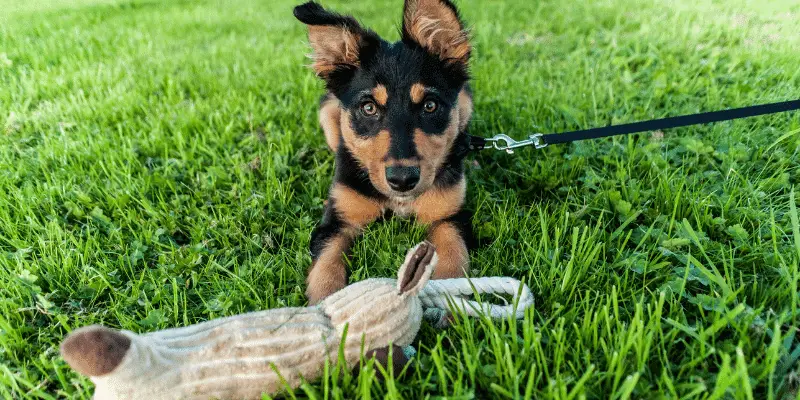
When can puppies go outside?
Puppies can go outside and explore public places one week after they’ve had their second vaccination, though some areas like rivers and farms should be avoided for at least a month after the final vaccination
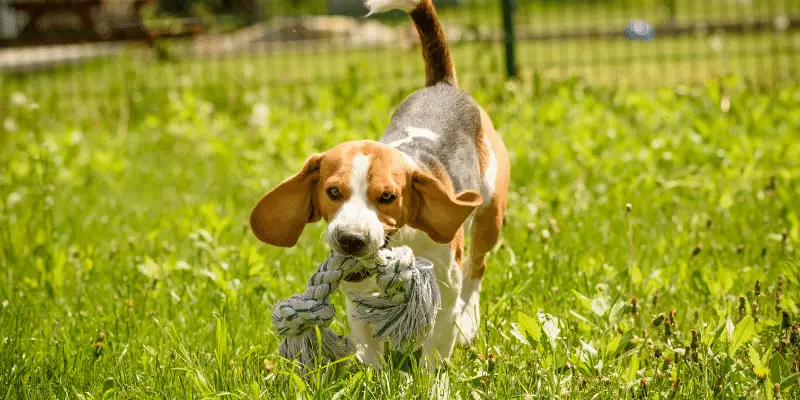
When can puppies go in the garden?
As long as your garden is clean, secure, and not used by unvaccinated dogs, your puppy can go in the garden as soon as you bring them home. Letting your puppy outside as soon as possible will help with toilet training and increase their confidence in outdoor spaces.
When can you take your puppy for a walk?
You can take your puppy for a walk when a week has passed after their second vaccination. Before then, you can start training your pup to wear a harness and lead, as well as go on “practice” walks around your garden.
How long should you walk a puppy?
Puppies need daily exercise to keep them stimulated and healthy, but they need far less exercise than adult dogs. Although your puppy’s breed, size, energy levels, and overall health will need to be taken into consideration to work out their daily exercise routine, a good rule of thumb is a ratio of 5 minutes of exercise per month of age, up to twice daily.
For instance, a 10-minute to 20-minute walk daily should be sufficient for an 8-week-old puppy. We have a more detailed guide on how to work out the amount of exercise your dog should get here if you’re interested!
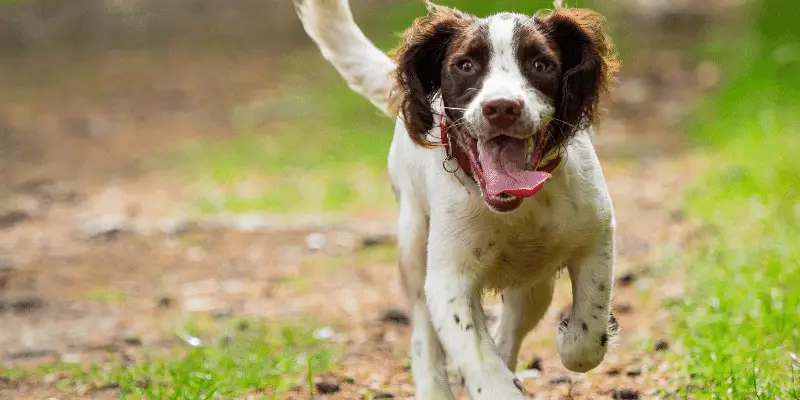
Signs of over-exercising puppy
While it’s important to exercise your puppy daily, you need to be careful not to overdo it. Over-exercising your puppy can be just as harmful as under-exercising as it can impact their musculoskeletal development. Large and giant breeds are most at risk of this as their growth can continue up until 18 to 24 months of age.
Signs that you’re over-exercising your puppy include:
- Stiff or sore muscles
- Lagging behind on walks
- Exhaustion after exercise
- Heat exhaustion
- Joint injury
- Excessive panting
- Sudden aversion to exercise
Over-exercising your puppy puts them at an increased risk of overheating, especially on hot days. Watch out for warning signs such as excessive panting, drooling, confusion, agitation, and vomiting. If your puppy displays the aforementioned signs, take them to a cooler area with shade immediately.
Apply cool or tepid water to your puppy’s fur, skin, under legs, and their belly. Fan your puppy with your hands to help them cool down rapidly, then take them to your closest veterinary clinic. Heatstroke in dogs, especially puppies, is a medical emergency and can be fatal if left untreated.
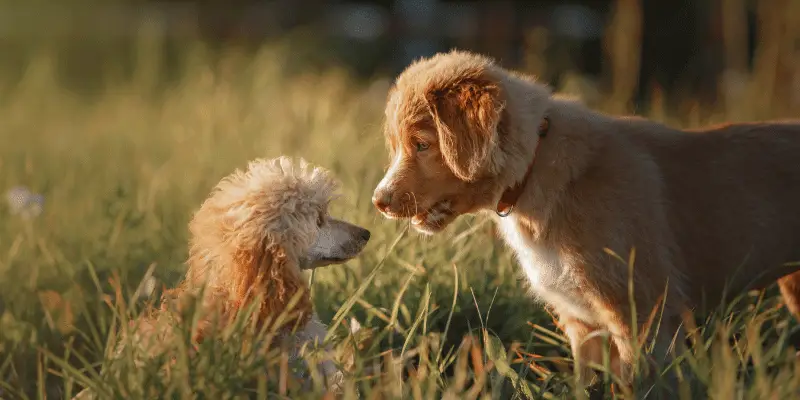
How often should you walk a puppy?
Puppies need to be walked every day. The amount of exercise your pup needs daily depends on their activity levels, age, size, and overall health, but as mentioned earlier, a good guideline to follow is a ratio of 5 minutes of exercise per month of age.
Once your puppy is fully grown, they can go on much longer walks.
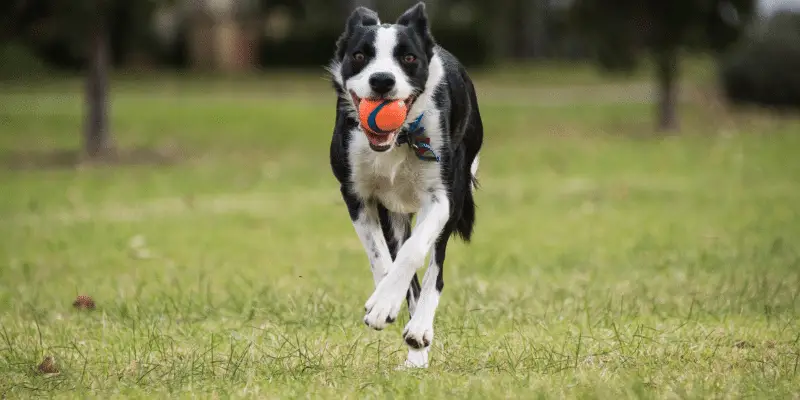
Why walking your puppy is important
Walking your puppy regularly is important as not only does it keep them in good shape, but it also keeps them mentally stimulated. Dogs need daily exercise to release excess energy and keep their brain active, which is crucial for both their physical and mental health.
Sadly, in a study conducted by the dog food company, Forthglade, it was revealed that 58% of UK dog owners admitted to not walking their pooches regularly or for as long as they should. This is an alarming figure and it can’t be stressed enough how crucial exercise is for dogs.
If your puppy doesn’t receive enough exercise, it can cause health problems like obesity, as well as behavioural issues. A bored dog is more likely to engage in destructive behaviours like chewing, over-grooming, digging, excessive barking, and even toileting inside the house.
Additionally, exercise helps tire out your puppy so they’re more likely to sleep through the night, which in turn, reduces your chances of being woken up by whining and crying!
Puppy socialisation on walks
A well-socialized puppy is a happier, more confident pooch than a poorly-socialized one, and regular walks are a great place to expose your dog to different experiences and other canines.
The critical socialisation period for puppies is between 3 to 17 weeks of age, so it’s important to subject your puppy to as many new things as possible within this time frame. This crucial period of development and learning will influence your puppy’s behaviour as an adult and shape the type of dog they will become.
Simply taking your puppy on daily walks will help them feel more comfortable around new sights, smells, and sounds. However, there are other ways to help socialize your puppy and help them become a well-mannered dog.
From 3 to 17 weeks of age, expose your puppy to as many new things as possible, such as:
- Strangers
- Other dogs
- Cats
- Other pets in your household
- Urban environments
- Body handling (tails, paws, ears)
- Vehicles
- Grooming (bathing, nail clipping, brushing teeth, etc)
- Woods, bodies of water, different types of flooring/terrain, etc
- Unfamiliar clothes (hoods, hats, sunglasses, etc)
- Common neighbourhood objects (bicycles, skateboards, pushchairs, wheelchairs, etc).
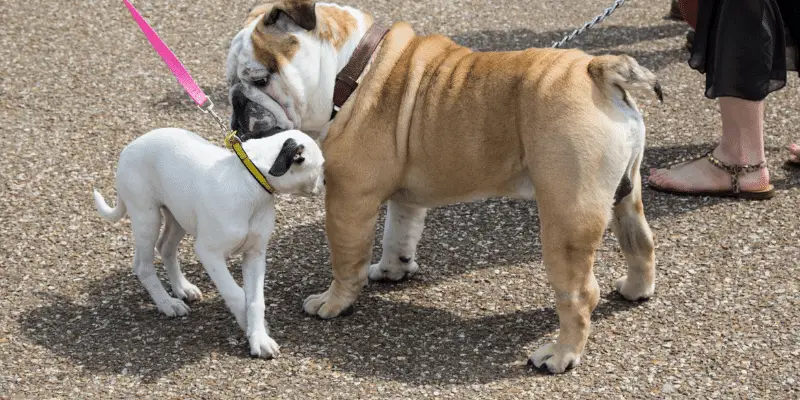
What’s the best time of day to walk a puppy?
The best time of day to walk a puppy is in the morning as it allows them to expel all their excess energy early, which can help assist with obedience training.
Additionally, morning temperatures are usually very mild, which is ideal during the summer months to prevent heatstroke and overheating in dogs.
For your puppy’s first few walks, select a time that’s usually quiet, such as before or after morning rush hour and the school run. Once they’ve built up their confidence, you can begin walking them at busier times of the day.
What equipment do you need for walking your puppy?
To keep your puppy safe and happy during their daily walks, you’ll need to make sure you and they are equipped with the appropriate equipment.
- Leash
- Harness
- Collar with ID tags
- Poop bags
- Treats
- Dog water bottle
- Dog first aid kit
- Flashlight (if walking early in the morning or late at night)
- Dog activity tracker
- Reflective gear (ideal for you and your puppy when walking during the dark!)
- Paw protectors or dog boots (ideal when walking over rough terrain or hot pavements)
- Dog coat (during the cooler months for short-haired breeds)
What to do if your puppy stops walking and won’t move
It’s not uncommon for puppies to stop and refuse to move during a walk, especially for their first few outings. Young dogs get “fear periods”, which are a normal part of their development. Most puppies get two fear periods: one between 8 and 11 weeks of age, then another around 6 to 14 months of age.
Whether your puppy is reluctant to go on a walk from the get-go or suddenly becomes afraid of the outside, it’s important to be patient and gentle. If it’s your companion’s first walk, it will likely be a scary, overwhelming experience. Go at your puppy’s pace and use encouragement to help your pooch view walks as a positive.
If your puppy is stressed or anxious while on a walk, don’t force them to go on. Take them back home.
Another reason why your puppy may be reluctant to walk is due to pain. Check that your puppy isn’t suffering from a wound or injury, and make sure their harness and collar are fitting properly and aren’t pinching.
You should be able to slide your pointer and middle fingers between your pup’s collar and their neck. If your fingers slide in easily but are snug against the collar and your dog’s neck, then your puppy’s collar is the right fit.
Alternatively, if your puppy is frightened of something in their environment or suffered from a traumatic event on their last walk, this can cause them to stop and refuse to move on walks.
Try to figure out what your pup is scared of, whether that’s a new odour, sound, or sight. A fearful puppy will usually have their ears laid back, tails tucked between their legs, and their body crouched.
Be calm, patient, and use lots of encouragement and praise. Try to desensitise your puppy to the object or experience. As mentioned earlier, exposing your puppy to unfamiliar things and surroundings as soon as possible will build up their confidence.
If you’re struggling to get your puppy to leave the house, practice taking them a few steps outside, then return inside until they feel more comfortable going a greater distance from home.
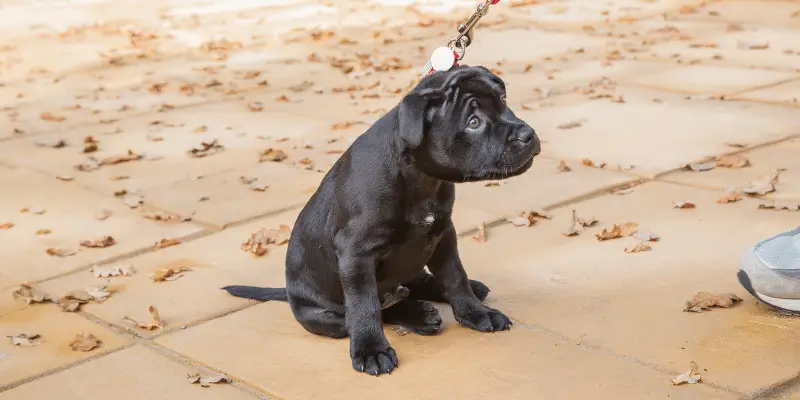
How far can a 12-week-old puppy walk?
A 12-week-old puppy can walk for around 15 minutes, but their breed, size, and overall health will ultimately influence their exercise capacity. For example, a 12-week-old chihuahua will need much less exercise than a 12-week-old border collie.
When should you let a puppy off the lead?
As long as your puppy has completed both their first and second vaccinations, you can let them off the lead at any time, but you’ll need to make sure the area is enclosed and secure, at least until they’ve grasped recall training.
It’s important to teach your puppy their name and to return back to you when called as, otherwise, you’ll have a hard time getting them to come back to you once playtime is over if they find themselves in a dangerous situation.
Start off indoors or in an enclosed space like your garden, and make sure you have plenty of yummy treats on hand. Call your dog’s name to get their attention, then use your recall cue like “come” or “here” (use a short word!) and step away from your puppy.
When your puppy returns to you, offer praise and a tasty snack. You should always make sure your rewards are enticing and exciting, particularly if your puppy is distracted by something interesting like another dog. Use a happy, excited tone of voice and friendly body language (arms wide open and crouched down).
Even if it takes some time for your puppy to come back to you, you should still reward them. Once your puppy is frequently returning to you when prompted, you can add in some distractions and increase the distance between you and your dog.
You can then move onto public areas like a park. Eventually, you won’t need to offer your pup as many treats. However, rewarding them every now and again will continue to keep them interested and motivated!
Puppy lead training
To start off your puppy’s lead training, slowly introduce your puppy to their walking gear (lead, harness, etc) inside the home. At first, simply let them sniff their lead and harness, making sure to use a lot of praise and treats to help boost your pup’s confidence.
You can then let your puppy wear their harness and lead for short periods of time, gradually increasing the duration. Again, encouragement and praise are key.
Once your pup is comfortable wearing their harness and lead, go on practice walks around your garden. When your puppy is walking around the garden like a pro, they’re ready to go to a public area. Choose a quiet time when there are few distractions and bring treats with you.
Continue to praise and reward your puppy for walking nicely on the lead. If they look like they’re about to lunge or get distracted, gently call their name or use another cue like “here”, then reward them with a treat for refocusing their attention on you.
Tips to encourage your puppy to love walks
- For the first few walks, carry your pup 20 or 30 feet away from your house and allow them to walk back. That way, even if your puppy is scared, they will know they are returning to an area where they feel safe, which will encourage them to continue moving.
- Drive a short distance away from your house and walk your pooch the way back.
- Drive to a new area, such as a quiet park or even a pet shop that allows dogs inside. If your puppy can’t see their home, it could persuade them to explore their surroundings.
- Enrol in puppy classes or a dog training class to help socialize your puppy and get some advice on how to properly train your pooch.
- Ask a family member or friend to walk your puppy while you stand a few steps away from them. This will persuade your pooch to move towards you instead of retreating backwards.
- Use a high-value treat or toy that your puppy only has access to on walks to make the experience more exciting and special!
Can I take my puppy out after the first vaccination?
You shouldn’t take your puppy outside until one week after they’ve completed their second round of vaccinations as, otherwise, they won’t be fully protected against diseases like canine parvovirus and canine distemper.
Final thoughts
Walking your puppy is key to their physical and mental health, so the earlier you get their lead training completed and vaccinations booked, the better. Remember, you’ll need to wait at least a week after your puppy’s second vaccination before you let them outside in public areas.
The first few walks will be the scariest and most overwhelming for your puppy, so it’s important not to rush things. Go slowly and use plenty of encouragement to help your puppy associate walks as a positive.
Once your puppy is comfortable walking outside in public places, you can increase the duration of their walk, but try to stick to the ratio of 5 minutes of exercise per month of age so you don’t overtire your companion. Over-exercising is just as detrimental to your puppy’s health as under-exercising!

